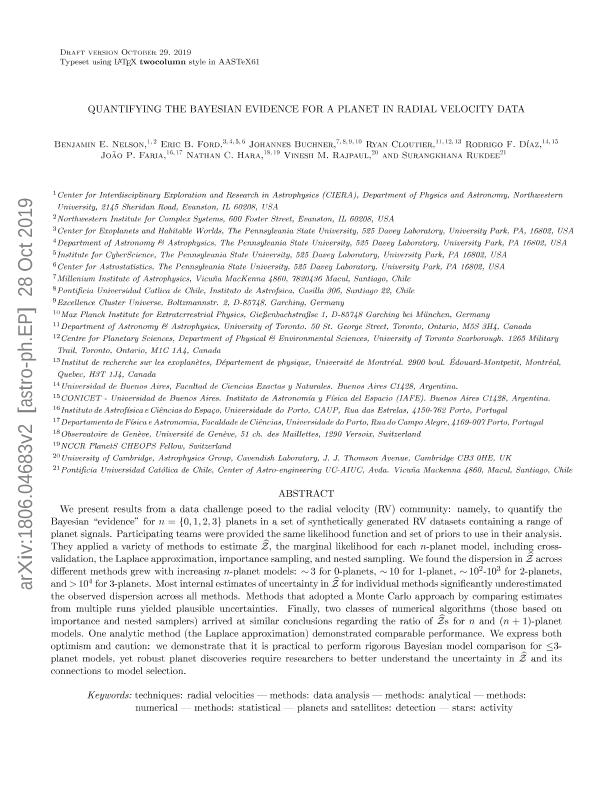Artículo
Quantifying the Bayesian Evidence for a Planet in Radial Velocity Data
Nelson, Benjamin E.; Ford, Eric B.; Buchner, Johannes; Cloutier, Ryan; Díaz, Rodrigo Fernando ; Faria, Joaõ P.; Hara, Nathan C.; Rajpaul, Vinesh M.; Rukdee, Surangkhana
; Faria, Joaõ P.; Hara, Nathan C.; Rajpaul, Vinesh M.; Rukdee, Surangkhana
 ; Faria, Joaõ P.; Hara, Nathan C.; Rajpaul, Vinesh M.; Rukdee, Surangkhana
; Faria, Joaõ P.; Hara, Nathan C.; Rajpaul, Vinesh M.; Rukdee, Surangkhana
Fecha de publicación:
02/2020
Editorial:
IOP Publishing
Revista:
Astronomical Journal
ISSN:
0004-6256
Idioma:
Inglés
Tipo de recurso:
Artículo publicado
Clasificación temática:
Resumen
We present results from a data challenge posed to the radial velocity (RV) community: Namely, to quantify the Bayesian "evidence"for n = {0, 1, 2, 3} planets in a set of synthetically generated RV data sets containing a range of planet signals. Participating teams were provided the same likelihood function and set of priors to use in their analysis. They applied a variety of methods to estimate the marginal likelihood for each n-planet model, including cross-validation, the Laplace approximation, importance sampling, and nested sampling. We found the dispersion in across different methods grew with increasing n-planet models: ∼3 for zero planets, ∼10 for one planet, ∼102-103 for two planets, and >104 for three planets. Most internal estimates of uncertainty in for individual methods significantly underestimated the observed dispersion across all methods. Methods that adopted a Monte Carlo approach by comparing estimates from multiple runs yielded plausible uncertainties. Finally, two classes of numerical algorithms (those based on importance and nested samplers) arrived at similar conclusions regarding the ratio of for n- A nd (n + 1)-planet models. One analytic method (the Laplace approximation) demonstrated comparable performance. We express both optimism and caution: We demonstrate that it is practical to perform rigorous Bayesian model comparison for models of ≤3 planets, yet robust planet discoveries require researchers to better understand the uncertainty in and its connections to model selection.
Archivos asociados
Licencia
Identificadores
Colecciones
Articulos(IAFE)
Articulos de INST.DE ASTRONOMIA Y FISICA DEL ESPACIO(I)
Articulos de INST.DE ASTRONOMIA Y FISICA DEL ESPACIO(I)
Articulos(SEDE CENTRAL)
Articulos de SEDE CENTRAL
Articulos de SEDE CENTRAL
Citación
Nelson, Benjamin E.; Ford, Eric B.; Buchner, Johannes; Cloutier, Ryan; Díaz, Rodrigo Fernando; et al.; Quantifying the Bayesian Evidence for a Planet in Radial Velocity Data; IOP Publishing; Astronomical Journal; 159; 2; 2-2020; 1-34
Compartir
Altmétricas



